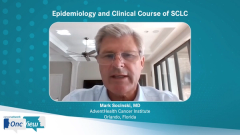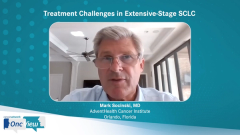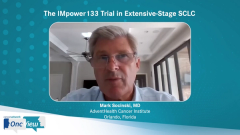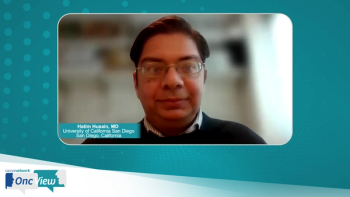
Epidemiology and Clinical Course of SCLC
An overview of the prevalence and prognosis of small cell lung cancer.
Episodes in this series

Kristie Kahl: Hi, and welcome to CancerNetwork®’s OncView videos series titled “Updates in the Management of Extensive Stage Small Cell Lung Cancer.” My name is Kristie Kahl, the editorial director of CancerNetwork. Our discussion is going to focus on recent advances in the frontline management of extensive-stage small cell lung cancer with Dr Mark Socinski from AdventHealth Cancer Institute. Welcome, and let’s begin.
Dr Socinski, how common is small cell lung cancer?
Mark Socinski, MD: It’s estimated to be about 13% of all lung cancers that we see in the United States. That translates into about 30,000 cases in the United States on an annual basis. So it’s not as common as it used to be. In past decades, going back to the 1980s or so, it was 20% to 25%. But we’ve seen a decrease largely because of a decrease in smoking rates.
Kristie Kahl: You just mentioned smoking. What are the risk factors for small cell lung cancer?
Mark Socinski, MD: Principally, smoking. It’s a very smoking-linked disease: 98% plus of patients have a significant smoking history. Other than smoking, there can be certain occupational exposures that increase the risk. Radon is a risk, family history is a risk—these sorts of things. But in day-to-day practice, it really is a smoking-related cancer.
Kristie Kahl: Definitely. What are the stages of small cell lung cancer? And with that, what’s the typical course of progression?
Mark Socinski, MD: We should be thinking of small cell lung cancer in the TNM system as we normally do in the management based on TNM. It probably shouldn’t be that much different from its more common partner, non–small cell lung cancer. However, based on the implications for radiation therapy, we’ve lapsed into what we refer to as limited stage vs extensive stage. Limited stage is defined as disease that can be contained within a reasonable and tolerable radiation port. And our technology over the years in radiation therapy has improved such that that definition has been a bit of a moving target so to speak. It turns out that only about 25% to 30% of cases fall into that limited-stage category. At least two-thirds to 70% or so really are extensive-stage disease. And extensive-stage disease is simply defined as beyond limited stage. If you have a malignant pleural effusion, or malignant pericardial effusion, that would be evidence of extensive-stage disease. Typically patients present with bone metastases, liver metastases, adrenal, brain metastases—these sorts of things—in extensive-stage disease. That’s the typical progression of this disease.
Kristie Kahl: What is the prognosis for a patient with small cell lung cancer, and what are the known prognostic factors?
Mark Socinski, MD: If you go way back to the 1960s, when we didn’t really have treatment, this was a rapidly fatal disease. Limited-stage disease had a median survival of 3 to 4 months; extensive-stage disease, in the 6-to-8-week range. So it’s a high aggressive disease if it’s untreated. Nowadays we do differentiate in limited-stage disease that it’s potentially curable, so that’s our goal. For extensive-stage disease, we’ve seen an improvement with treatment up to that the median survival nowadays is measure at about a year. There are even some 2-year survivors in the range of 20% or so, which was unheard of before we developed effective therapy. Some of the known prognostic factors are, obviously, performance status, high LDH [lactate dehydrogenase] levels, extensive-stage disease, the more sites of metastases and more bulky disease. Certainly comorbidities can sometimes be limiting and alter the prognosis of patients because they have other illnesses that are linked to smoking and that sort of thing. It’s a complex group of patients.
Kristie Kahl: What makes small cell lung cancer so difficult to treat?
Mark Socinski, MD: When I trained years ago, small cell we used to refer to as the chemotherapy- and radiation-sensitive cancers. Certainly, we see high response rates, but it develops resistance to disease relatively soon. It’s because this is a tumor that has lots of mutations. Many of the mutations are in tumor suppressor genes. It’s just a rapidly resistant tumor to our current therapies that we use. Even though we’ve considered it sensitive to treatment, it rapidly develops resistance. It’s largely because of the makeup of the molecular nature of the disease being characterized mostly by tumor suppressor gene alterations.
Transcript edited for clarity.
Newsletter
Stay up to date on recent advances in the multidisciplinary approach to cancer.




















































































